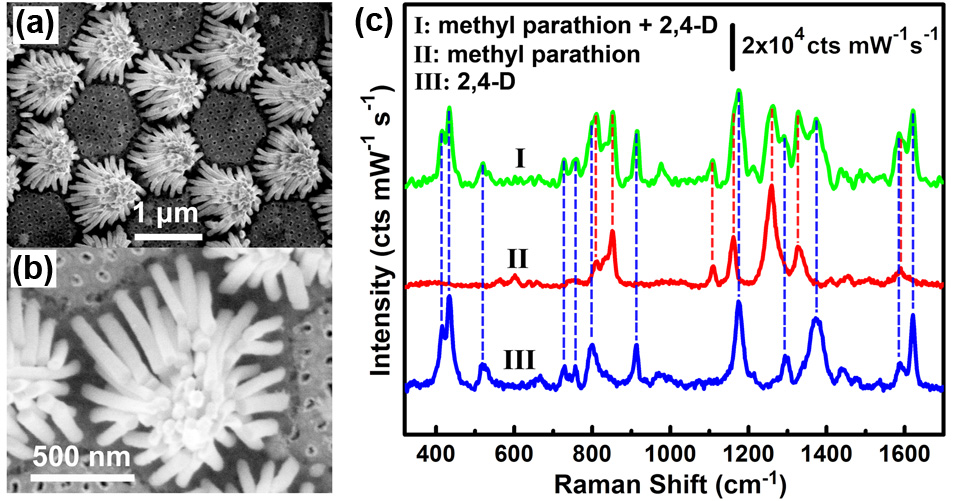Pesticides, whose compounds could be released to the aquatic environment, are widely used in agriculture. In fact, excessive exposure to pesticides may cause adverse health effects. Hence, maximum residue limits for pesticides in surface water are set by National Standards of P.R.China. And pesticide residues are typically measured by large-scale analytical instruments such as high-performance liquid chromatography. Given this, developing portable sensitive sensors remains in need. Field-deployable portable surface-enhanced raman scattering (SERS) devices enable inexpensive and timely monitoring of pesticide residues. For SERS detection, it is essential to develop highly sensitive and uniform SERS substrates with high signal reproducibility. However, it still remains a challenge to develop facile and inexpensive approaches for fabrication of such substrates for realization of sensitive and reliable monitoring of pesticide residues.
Aiming at this problem, the research group led by Prof. MENG Guowen at Institute of Solid State Physics, Hefei Institutes of Physical Science, joined hands with the research group of Prof. WU Nianqiang at West Virginia University and the research group of Prof. HUANG Qing at Institute of Technical Biology and Agriculture Engineering, to demonstrate a simple and cost-effective approach for fabrication of large-area ordered arrays of silver nanorod bundles using a binary-template-assisted electrodeposition method and realize sensitive and reliable detection of pesticide in water based on the SERS effect of the fabricated silver nanorod bundle array.
In their work, the optimized Ag-nanorod bundles are hexagonally laid out, in which each bundle consists of 30–45 leaning Ag-nanorods. A small gap (about 2 nm) is formed between the adjacent nanorods during the capillary force-induced closure process, which results in a large number of high-density “hot spots” in the whole chips, leading to a high SERS enhancement factor up to 108 and high sensitivity.
Additionally, finite-difference time-domain (FDTD) simulation revealed that high-density “hot spots” and thus high sensitivity were generated due to strong electromagnetic field coupling among the neighboring Ag-nanorods with the narrow ≈2 nm gaps at the top end.
Furthermore, the relative standard deviation of the characteristic peak intensities is less than 10%, demonstrating the high reliability and reproducibility of the SERS signal from the Ag-nanorod bundle array.
Therefore, the as-fabricated high-quality SERS substrate was employed to successfully detect trace phenolic pollutants in water, such as methyl parathion (an organophosphorous pesticide), 2,4-dichlorophenoxyacetic acid (2,4-D, an organochlorine pesticide), and a mixture of the two pesticides.
This work sheds new light on nanoscale fabrication of a large-area (≈1 cm2), highly ordered nanorod bundle array with good uniformity and reproducibility, which facilitates the application of SERS detection in chemical analysis, environmental monitoring, food safety and healthcare.
This work was published in Advanced Materials entitled A Hierarchically Ordered Array of Silver-Nanorod Bundles for Surface-Enhanced Raman Scattering Detection of Phenolic Pollutants.
This research was financially supported by the National Key Basic Research Program of China SRG-HSC and Anhui Provincial Natural Science Foundation.

SERS detection of pesticides in water by using the fabricated Ag-nanorod bundle array. (a,b) Scanning electron microscopy (SEM) images of the as-prepared Ag-nanorod bundle array with different magnifications, and (c) SERS detection of multiple trace organic pollutants using the as-prepared Ag-nanorod bundle arrays: (Curve I) SERS spectrum of the mixture of 0.3×10?6 M methyl parathion and 2×10-6 M 2,4-D, and SERS spectra of pure aqueous solutions of (Curve II) 0.3×10-6 M methyl parathion and (Curve III) 2×10-6 M 2,4-D, respectively.(Image by ZHU Chuhong)
Contact:
MENG Guowen
Institute of Solid State Physics (http://english.issp.ac.cn/)
Hefei, Anhui 230000, China
Tel:86-551-65592749
E-mail:gwmeng@issp.ac.cn
 Tel: +86-551-65591206
Tel: +86-551-65591206
 Fax: +86-551-65591270
Fax: +86-551-65591270
 Emai: zhous@hfcas.ac.cn
Emai: zhous@hfcas.ac.cn
 350 Shushanhu Road
350 Shushanhu Road